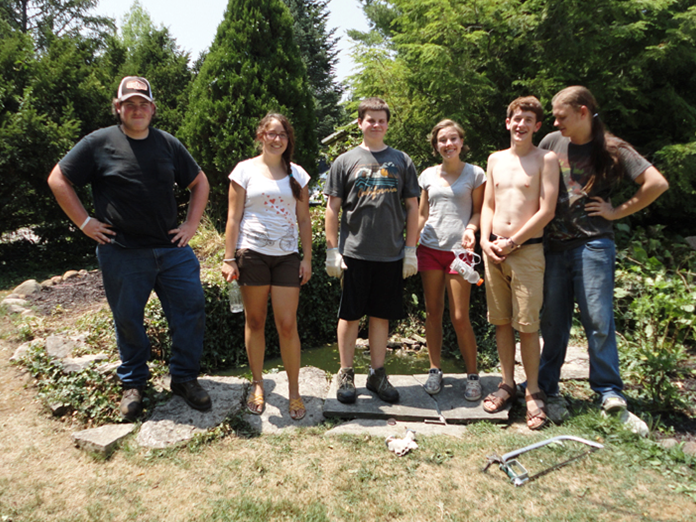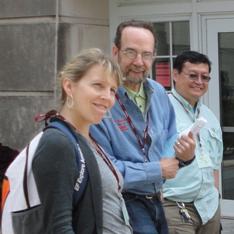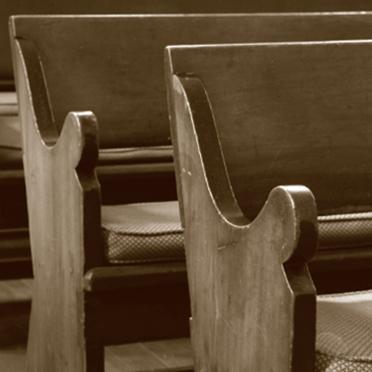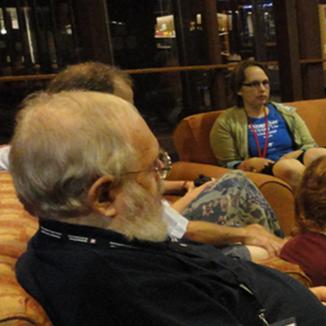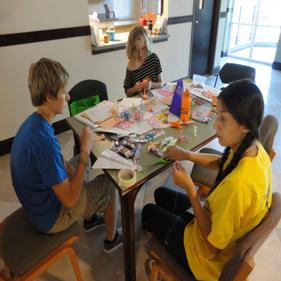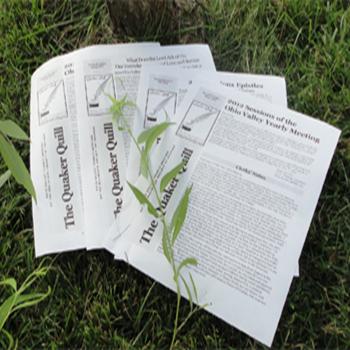Quaker History
The Society of Friends originated in England at the time of the Puritan Revolution (about 1628-1660). The overthrow of the monarchy was the result of a growing sense of personal independence among the people, which politically established Oliver Cromwell as protector and religiously produced many revolts against the established church. The latter tendency resulted in many quick-growing but often short-lived sects and in a large number of restless, searching spirits.
George Fox, the founder of Quakerism, was of this seeking type of mind. Born in 1624, he began when nineteen years old a solitary, spiritual quest of truth. He records in his Journal that at last in 1646, "when all my hopes in...all men were gone, so that I had nothing outwardly to help me, nor could tell what to do, then, O then, I heard a voice which said, 'There is one, even Christ Jesus, that can speak to thy condition,' and, when I heard it, my heart did leap for joy."
In 1647 Fox began to preach, convincing many persons, and in 1648 a whole community in Nottinghamshire accepted his message and, associating together, called themselves Children of the Light, the earliest name by which Friends were known. From this time on the number of his followers grew rapidly.
Puritan ministers were then teaching that God's revelation to humanity lay in the Bible and in the work of the historic Christ and that, until the judgment at the Second Advent, God would not speak again. Fox proclaimed that God speaks directly to each human soul through a present, living experience of revelation, the Inner Light, requiring no human mediator to translate its meaning to the individual.
George Fox was a powerful personality. In him was "combined in a singular degree the burning zeal of the enthusiast with the magnetic force of a born leader of men." He was his own best illustration of the truth he preached, "...that a single man or woman living in the spirit of the apostles and prophets would shake all the country...for ten miles around."
He soon attracted around him a group of young men and women who became inspired preachers of this new religious force and were called Publishers of Truth. These were later joined by other earnest men and women. They engaged in the heroic work of spreading the movement, traveling in twos and threes through the length and breadth of England, extending their labors also into Wales, Scotland, and Ireland, although often hindered by imprisonment and persecution. Undismayed by every sort of difficulty, they fed the inward spiritual flame of widely separated groups, stimulating their zeal, holding them in the bond of group-consciousness, and providing for them a channel of communication.
Margaret Fell, often called the Mother of Quakerism, was an early convert and a powerful personality. Swarthmore Hall, her home, became a center of activity, a stable focal point giving the movement a sense of community and strength. She set up a central fund to which Friends could contribute to help those on long preaching trips, in prison, in isolated meetings and to promote the setting up of women's meetings. Eleven years after the death of her husband, Judge Fell, she and George Fox were married.
The powerful preaching of these leaders was supported by the daily life of the first Friends. Along with an intense religious fervor there ran a life of practical righteousness. Justice, temperance, commercial honesty, and the complete observance of all civil laws that did not violate their conscience were vitally important matters. "None could dispute the validity of a Christianity which resulted in consistent and Christ-touched lives. In such lives, amid all their imperfections, the Inward Light was justified of its children."
A deep realization of the equality of all persons before God led to the early recognition of the spiritual gifts of women as well as men and to the acceptance of their public preaching. It brought about the use of the "plain" language and the refusal to remove the hat to superiors, customs which caused frequent persecution; and still greater suffering resulted from the refusal to take oaths or later to pay tithes for the upkeep of the state church.
With the restoration of the Monarchy, the Anglican Church was re-established and no other worship was permitted. An era of persistent persecution was inaugurated for all non-conformists, during which the Friends endured long imprisonments, disastrous fines and cruel treatment. Their meetings were often broken up and the meeting-houses destroyed. But because their consciences assured them that resistance to the law was no sin, they continued their way of worship openly and bravely in spite of every effort to stop them. In some places when all of the adult Friends were in jail, the children held the meetings alone.
This faithfulness in persisting according to their religious conviction, with no evasion of the penalties of the law, was a factor of importance in finally winning for England liberty of conscience and religious toleration. But for the Society of Friends itself, the persecution had some unfortunate results: it paralyzed the itinerant services of the Publishers of Truth, isolated the meetings and hastened the necessity for organizing into a sect what had been a glorious creative movement.
From 1667 on, George Fox was active in helping to organize the system of monthly, quarterly, and yearly meetings and in arranging methods of procedure therein. Women's business meetings were set up in addition to men's. A Meeting of Ministers and a Meeting for Sufferings were established.
The earliest concerns of these business meetings were for the poor and for prisoners, checking the vagaries of individual judgment, admonishing delinquents, and also providing for carrying on work at home and for expenses of ministers traveling beyond the seas, and for the keeping of records. While the discipline thus set up was no equivalent for the compelling power of wide-spread evangelism, it did foster well-ordered and noble lives. Efforts at formulation of doctrine soon followed, and in this, Robert Barclay (1648-1690) was the foremost figure. His most complete exposition was his Apology. His Quakerism was affected by current Puritan theology. The influence of his writings was so great as to be felt as late as the nineteenth century when the various separations occurred within the Society of Friends.
A period of development in a sect was underway. Along with the formulation of doctrine there were growing experiments toward improving the social order. These included refusal of election bribes and justice toward workmen and employees. Efforts were made to reestablish the poor in business, along with plans for giving work to those in prison, the establishment of workhouses, and active concern for the treatment of the insane. Temperance and the question of Negro slavery claimed attention of Friends. In Pennsylvania and Rhode Island bold attempts were made to establish truly Christian commonwealths.
As early as 1655 the New World had attracted Friends, and efforts were made during the following years to plant the seeds of Quakerism in Massachusetts, New York, and Virginia. In the last two colonies there were some persecution, but the martyrs of Quakerism in America met their test in Massachusetts. Everything that they authorities could devise was tried to stop the publishing of the Quaker truth in this colony. Harrowing tortures were endured, many underwent punishment again and again, and four suffered death. After ten years of persecution, they succeeded in breaking down the intolerant laws.
During this period a haven was found in Rhode Island, where the first meeting in the New World had been established. This colony became the center of New England Quakerism. Its long line of Quaker Governors and men in public places did eminent service in the political life of the colony until the time of the Revolutionary War.
A period of expansion followed George Fox's visit to America in 1671-1673. Meetings were established in New York, Maryland, Virginia, and the Carolinas, and in greater numbers in New Jersey and Pennsylvania.
These last two colonies had been opened for settlement rather later than the others, but conditions were especially favorable. West Jersey was bought by a group of Friends in 1674 and in 1681 Pennsylvania was granted to William Penn, so that here the Quakers had freedom and peace and unparalleled opportunity to try out their ability to conduct a Christian government. William Penn was a statesman of high order and he stands to this day an outstanding advocate of justice for Native Americans and a champion of liberty of conscience. He designed a government based on his advanced ideas of civil and religious liberty and equality, which was a forerunner of the Constitution of the United States. Friends maintained an almost absolute control of Pennsylvania until 1740 and were a power for fifteen years longer, when war-like measures forced them to resign from the Assembly.
The successful policy of Friends toward the Indians was the outcome of their sense of justice and of their conviction that before God all persons are equal, irrespective of their color, and these principles slowly formed their attitude on another great question-that of Negro slavery. George Fox had advised in 1671 giving slaves their freedom after a period of years. Philadelphia Yearly Meeting advised against the slave trade in 1696, and sentiment grew slowly until 1758 when John Woolman made a moving plea for the liberty of the slaves and began the great work of his life for this race. He aroused Friends in both America and England, many of whom became influential factors and tireless workers until slavery was finally abolished.
Friends’ opposition to war largely took them out of public life during the French and Indian wars prior to the Revolution, and this fact together with an increasing quietism caused a profound transformation in the Society. More and more Friends of the latter half of the 18th century withdrew from the outside world and centered upon perfecting their own spiritual lives, hedging their Society about the rules and customs of a peculiar people. This preserved some valuable features, but it also brought a narrowing introspection that was fertile ground for controversy.
Early in the 19th century two very divergent tendencies could be seen within Quakerism. One was toward a zealous evangelism which was fostered by a number of prominent ministers, some of whom came over from England, and which was accelerated by the popular rise of the Methodist movement. The other was toward a reaffirmation of the Inward Light as a sufficient basis for faith. Job Scott, a saintly man and true mystic, and Elias Hicks, a prophetic minister of liberal Quakerism, were the chief spokesmen for the latter.
The chasm grew steadily wider until 1827 when a separation occurred in Philadelphia Yearly Meeting. This tragedy, due to lack of historical knowledge, lack of spiritual understanding and lack of love for one another, was followed by withdrawals by one side or the other in many other Meetings, forming so-called "Hicksite" and so-called "Orthodox" branches. Further separations occurred within the Orthodox body.
Yet the 19th century did contain some advances in Quaker development. A great migration of Friends into new territory of the northwest took place, and new Yearly Meetings in Ohio, Indiana and Illinois were established.
The retirement of Friends from public affairs helped to stimulate their zeal for purely moral causes, such as the abolition of slavery, the welfare of the Negroes and the Indians, the work for social morality, the suppression of liquor traffic, and prison reform.
The women's rights movement grew out of the involvement of Quaker women in the anti-slavery movement. Several women, by lecturing extensively against slavery, did much to break down the barrier against women speaking in public. Lucretia Mott, Quaker minister and abolitionist, along with Elizabeth Cady Stanton, called the Seneca Falls Convention in 1848 which marked the formal beginning of the organized crusade for the rights of women.
Education has been a deep concern of Friends from their earliest history, and Monthly Meeting schools, boarding schools and colleges have been established.
The testimony for peace has been a cardinal principle ever since George Fox said in 1651 that he "lived in the virtue of that life and power that took away every occasion for all wars." In all the years of their existence Friends have maintained with a large degree of consistency and often with much suffering the belief that the power of love and the spirit of justice are the only solution for international disputes. The conflict of 1914-18 questioned with startling sharpness the validity of such a testimony. Friends now found themselves faced with the necessity for profound reasoning and active work in the pressing of this great principle, and their most cogent argument was the fearless and impartial service to the victims of war. During the course of the struggle the vision and leadership of Rufus Jones brought together all branches and all types of Friends in the effort to convey help and a message of love to the people of Europe. This resulted in the founding of the American Friends Service Committee on April 30, 1917, by Friends representing several areas of Quakerism. They were deeply concerned for the spiritual values endangered by America‘s entrance into the war, and they also wanted to provide constructive, non-military service to young men who were conscientious objectors.
When the peace treaty was signed in the summer of 1919 and it was possible to enter Germany, the AFSC, at Herbert Hoover's request, instituted a large child-feeding program. Relief was carried on in Austria and Poland, and a famine relief program in Russia was undertaken.
The work of the AFSC today is organized into programs that reflect concerns and testimonies shared widely among Friends in the United States. The executive secretary and associates coordinate the work of the Committee, but it is the Corporation, comprising more than 200 Friends from nearly 20 yearly meetings, that constitutes the legal entity of the AFSC. It is the Board of Directors-all of them Friends selected by the Corporation from its members-that determines AFSC policy.
Friends World Committee for Consultation was established by a Minute of a World Conference of the Religious Society of Friends held at Swarthmore, Pennsylvania, in 1937. Among its purposes are the encouragement and strengthening of the spiritual life within the Society and the promotion of understanding and consultation among Friends of all cultures, countries and languages.
All Yearly Meetings and similar organized groups of Friends throughout the world who wish to become affiliated with the Committee send representatives to its Triennial Meetings. A representative Interim Committee is appointed at each Triennial Meeting to assist staff and officers of the organization's world headquarters, located in London. In addition, Friends World Committee for Consultation has formed the following geographic sections, which have their own officers and staff to carry on regional concerns: African Section; European and Near East Section; and Section of the Americas (with the main office in Philadelphia, a mid-west office in Plainfield, Indiana, and a recently established office in Mexico City serving Latin America). Friends World Committee for Consultation publishes material of interest to all Quakers, encourages intervisitation, holds conferences and promotes concerns such as Right Sharing of World Resources.
The Friends World Committee for Consultation sponsored the Quaker United Nations Program in 1947 when FWCC acquired the non-governmental consultative status necessary for its operation. During the years since then the AFSC has administered the New York Quaker U.N. Office. A unique role is played both at New York and at Geneva by the Quaker House close to the offices of the United Nations, where delegates from opposing factions can meet informally and search for ways to reconcile their differences. The Q.U.N.O. staff also provides information to Friends about the U.N. and arranges for Friends and others to attend seminars and U.N. sessions so that they may better understand the work of this world organization.
Founded in 1943 by a group of Friends gathered at Quaker Hill in Richmond, Indiana, the Friends Committee on National Legislation is the oldest religious lobby in Washington D.C. The first executive secretary was E. Raymond Wilson, who spearheaded the work for two decades. While it has been recognized from the beginning that the FNCL does not speak for all Friends in the United States, it is equally clear that a majority of American Quakers believe in and support the ideas advanced by the Committee and its staff. Its policy-making body consists of appointees from worshipping bodies of Friends throughout the United States. It has long been and continues to be effective in presenting the viewpoints of Friends to members of Congress and to the executive branch of government.
Pendle Hill was founded in 1930 by members of the Society of Friends as a study center, incorporating study, work and recreation, in a unique community. It is concerned with the ongoing search for integrity and joy in being human-a search both individual and corporate, drawing upon the roots and raw materials of religious experience.
In 1977 there were 29 Yearly Meetings in the U.S. and Canada. These Yearly Meetings of Friends in North America are classified in five groups: Friends General Conference, Friends United Meeting, Evangelical Friends Alliance, Conservative, and independent Yearly Meetings not related to the four associations. There is a small but significant category of Meetings which have no formal yearly meeting association.
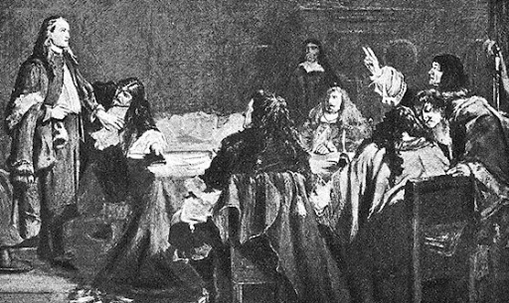 Fox refusing to swear an oath by John Pettie | 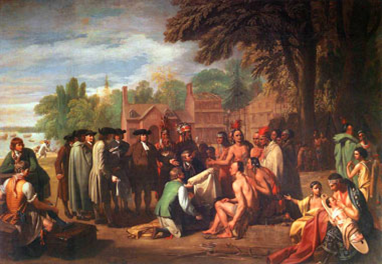 William Penn's treaty with Native Americans by Edward Hicks |


